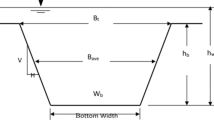Abstract
Breaching flow occurs during the breach development of the embankment, dike, earthen dam, landslide barrier, etc. and plays an import role in the breaching erosion as the driving force. According to the previous research, the breaching process can be classified into initiation phase, breach widening phase and breach deepening phase. Based on the breaching development classifications, the breaching flow can be seen as a special compound weir flow when the breach channel is in the relatively equilibrium condition. There were five physical flow models were designed in the hypothesis of rectangular shape and trapezoidal shape for the breach channel cross sections to study the breaching flow characteristics. The distributions of water level and velocity were measured and analysed in the breaching flows in overtopping condition and emerged condition. There were two helicoidal flows above the breach channel slopes and triangular hydraulic jump in the downstream of the breach channel in the overtopping condition and emerged condition. The hydraulic energy loss was calculated according to the breaching velocity and water level distribution in the upstream and downstream of the model. It is found that the test results of the breach flow physical model can be valuable to bring insight of the breaching process of embankment and make contributions to the validations and verifications of breach numerical models.
Similar content being viewed by others
References
VISSER P. J. Breach growth in sand-dikes[D]. Doctoral Thesis, Delft, The Netherlands: Delft University of Technology, 1998.
ZHU Y. H., VISSER P. J. and VRIJLING J. K. Review on embankment dam breach modeling, new developments in dam engineering[M]. London, UK: Taylor and Gracis Group, 2004.
ZHAO G., VISSER P. J. and PEETERS P. et al. Headcut migration prediction of the cohesive embankment breach[J]. Engineering Geology, 2013, 164(18): 18–25.
ZHAO G., REN Y. and VISSER P. J. et al. Hydraulics of dam breaching flow[C]. Proceedings of 24th ICOLD Congress. Kyoto, Japan, 2012.
ZHAO G., VISSER P. J. and VRIJLING J. K. Breach growth of cohesive embanks[C]. 3rd International Workshop on River and Reservoir Hydrodynamics and Morphodynamics. Lisbon, Portugal, 2012.
ZHAO G., VISSER P. J. and PEETERS P. Large scale embankment breach experiments in flume[R]. Report of Delft University of Technology, Flanders Hydraulics Research and Rijkswaterstaat, 2013.
ZHAO G., VISSER P. J. and PEETERS P. et al. Hydrodynamic erosion of cohesive embankment breach[C]. Proceedings of 7th International Conference on Scour and Erosion. Perth, Australia, 2014.
PEETERS P., ZHAO G. and De VOS L. et al. Largescale dike breaching experiment at lillo in Belgium[C]. Proceedings of 7th International Conference on Scour and Erosion. Perth, Australia, 2014.
GÖGÜS M., DEFNE Z. and ÖZKANDEMIR V. Broadcrested weirs with rectangular compound cross sections[J]. Journal of Irrigation and Drainage Engineering, 2006, 132(3): 272–280.
BOS M. G. Discharge measurement structures[M]. 3rd Edition, Wageningen, The Netherlands: ILRI publication, 1989, 20.
SINGH V. Dam breach modelling technology[M]. Dordrecht, The Netherlands: Kluwer Academic Publishers, 1996.
WAHL T. L. Uncertainty of prediction of embankment dam breach parameters[J]. Journal of Hydraulic Engineering, ASCE, 2004, 130(5): 389–397.
WALDER J. S., O’CONNOR J. E. Methods for predicting peak discharge of floods caused by failure of natural and constructed earthen dams[J]. Water Resources Research, 1997, 33(10): 2337–2348.
WANG P., KAHAWITA R. Modelling the hydraulics and erosion process in breach formation due to overtopping[C]. Proceedings of the Symposium held in Monte Veritá. Monte Veritá, Switzerland, 2002.
MORRIS M. W. Impact: Investigation of extreme flood processes and uncertainty[C]. Proceedings of the 40th Defra Flood and Coastal Management Conference. York, Uk, 2005.
Author information
Authors and Affiliations
Corresponding author
Additional information
Biography: ZHAO Gensheng (1982-), Male, Ph. D., Researcher
Rights and permissions
About this article
Cite this article
Zhao, G., Visser, P., Ren, Y. et al. Flow hydrodynamics in embankment breach. J Hydrodyn 27, 835–844 (2015). https://doi.org/10.1016/S1001-6058(15)60546-7
Received:
Revised:
Published:
Issue Date:
DOI: https://doi.org/10.1016/S1001-6058(15)60546-7




